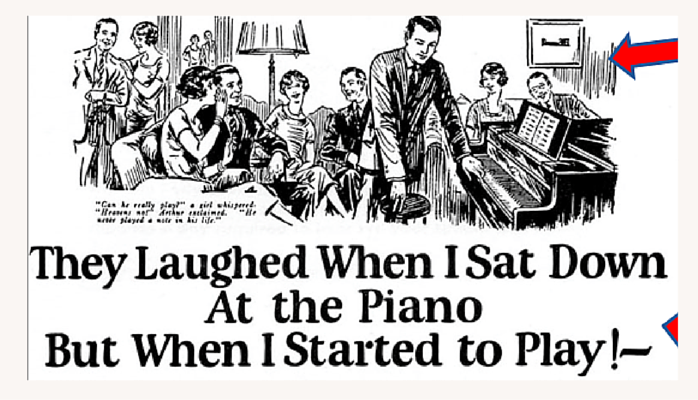
Today, I want to share with you some of the principles of Direct Response Marketing from a CLASSIC 1926 ad that still works today and can work for you and your business.
Here’s the ad:

This was created by John Caples for the U.S. School of Music in 1926 and is one of the most effective direct response ads of all times. Even today variations of this ad work very well. Scott DeLong who launched the successful ViralNova website has a copy of this ad over his desk and credits it for much of his success.
Let’s look into the success points of this famous ad and how you could use them.
Number 1 – Great Eye-Catching Image
You have to grab the reader’s attention with a great image. The more emotional the setting can be the better. Here Mr. Caples captures a great moment in time. The moment when his potential customer was going to sit down and play the piano for a group of people for the first time. People are smiling and there’s a little whisper… “Can he really play?”. You can choose and test images for your ads. Keep them eye engaging and create an emotional moment in time. The more emotion the better.
Number 2 – Great Headline (most important of all)
This is one of the best headlines of all time. It’s so famous you could google it and study it for hours!
“They Laughed when I Sat Down At the Piano… But When I Started to Play!”
Mr. Caples realized he was not selling piano lessons. Learning the piano is hard, mastering it is almost impossible for most people. What he was selling was the popularity, admiration and envy of others for the person that can play the piano. He was selling the feeling you get when you can entertain people. People buy on emotion and then justify with logic. He also realized that the emotional almost underdog appeal of someone who people thought could not do it – actually does it! They laughed at him but then he won them over. Spend the most of your time creating, testing and tweaking your Headline. It’s the most important part – if you don’t have a Headline that stops the reader the rest of your marketing does not matter. Think about how you could use the headline yourself: “They Laughed When…”
Number 3 – Good Sub-Headlines
People usually scan ads. You need good sub-headlines in bold that tell the story for the quick scanning reader. His sub-headlines tell the whole story:
Then I Started to Play
A Complete Triumph!
How I Learned to Play Without a Teacher
Play Any Instrument
Send for Our Free Booklet and Demonstration Lesson
Number 4 – Clear Free Easy Simple Offer
You have to have a free simple offer for people to take advantage of. You need to give specific clear instructions. Mr. Caples is perfect:
Send for Our Free Booklet and Demonstration Lesson
Take a look at your own ads. Is it very clear what you are offering? Is it simple? Is it easy?
Number 5 – Simple Response Mechanism
You need to keep it easy for someone to respond. Mr. Caples uses a simple form to fill out and mail back in. This was about as simple as you can get in 1926 and this one ad created a whole career in advertising for Mr. Caples. How do your ad responses work? Do you make it as easy as possible? Do you capture initial information first like just name and email then move on to getting more detailed information? Keep it as simple as possible. Even just one extra click online can decrease response.
Now your know Mr. Caples and his famous Piano Ad! Let me know what you think or if you have any other famous ads I could look at.
Now take control and make it a great day!
Blaine Oelkers
Blaine Oelkers is a lifetime entrepreneur, a graduate of Purdue University and Stanford University’s Entrepreneurship program. He’s achieved over 100 Million dollars in sales and coached 1000’s of people. He’s currently President of the Arizona Marketing Association and a company called Selfluence. He helps business owners with their Personal Implementation Plans (PIPs) elevating themselves to a higher level called You 2.0. He can be reached at Blaine@ForcedClarity.com






